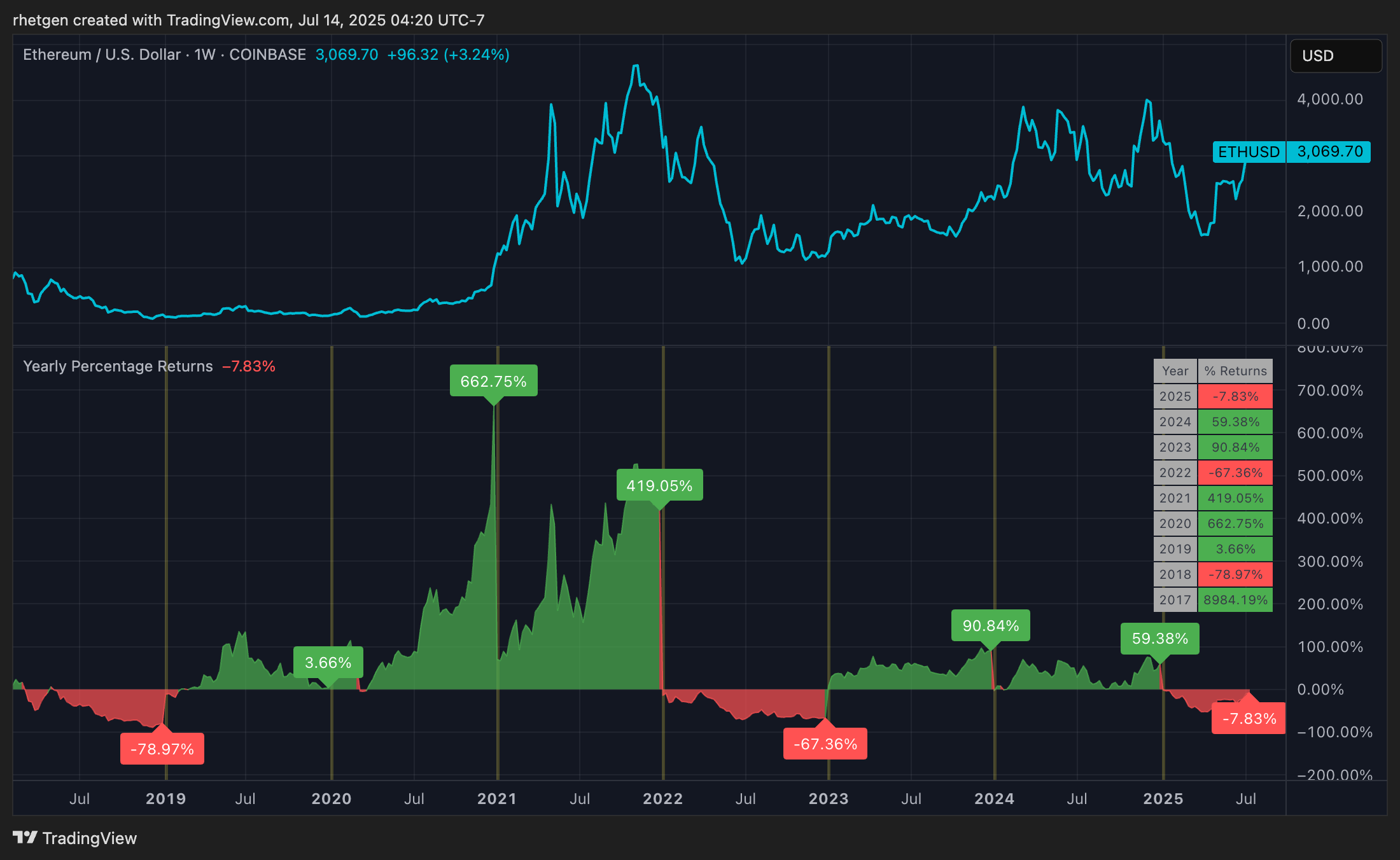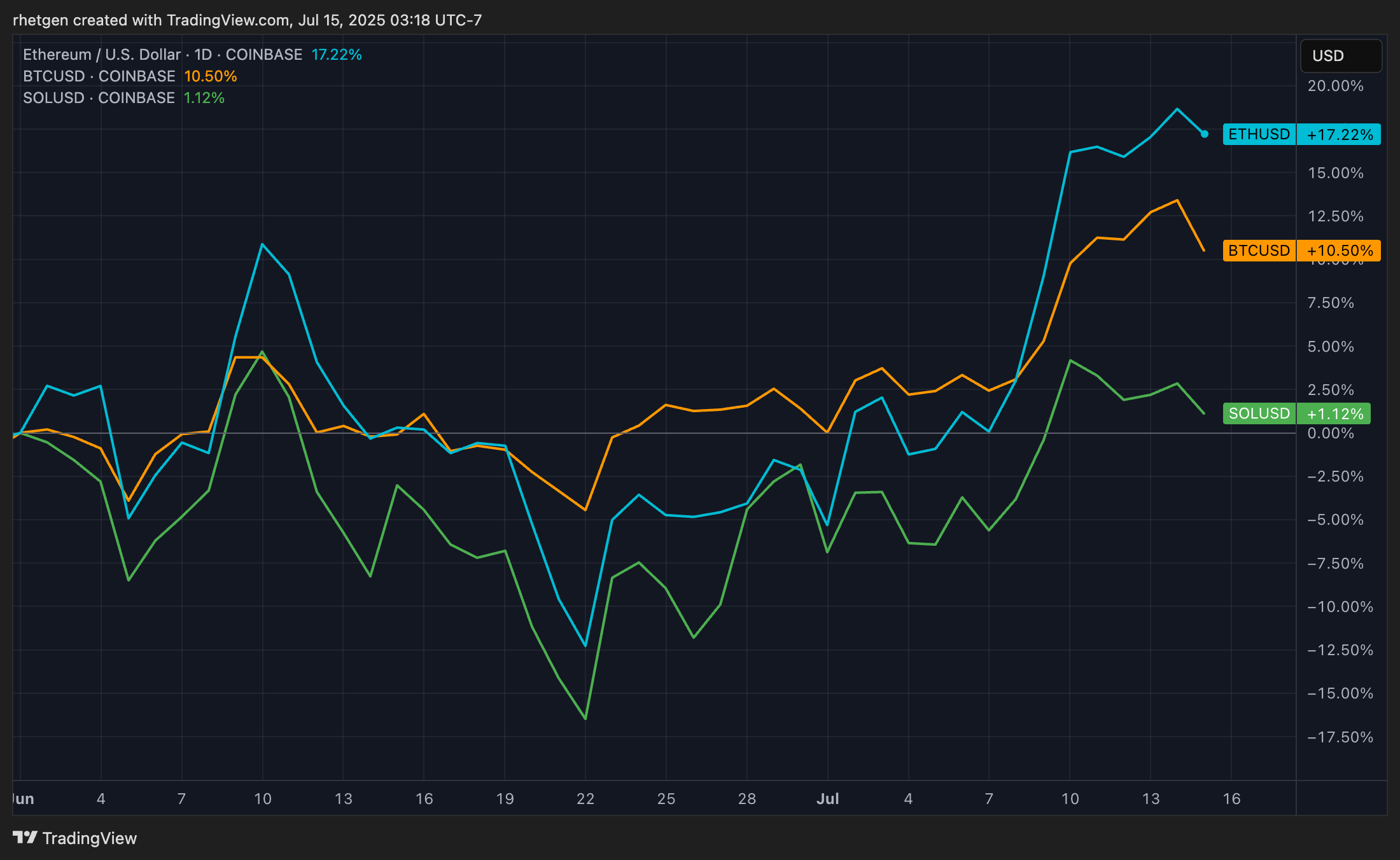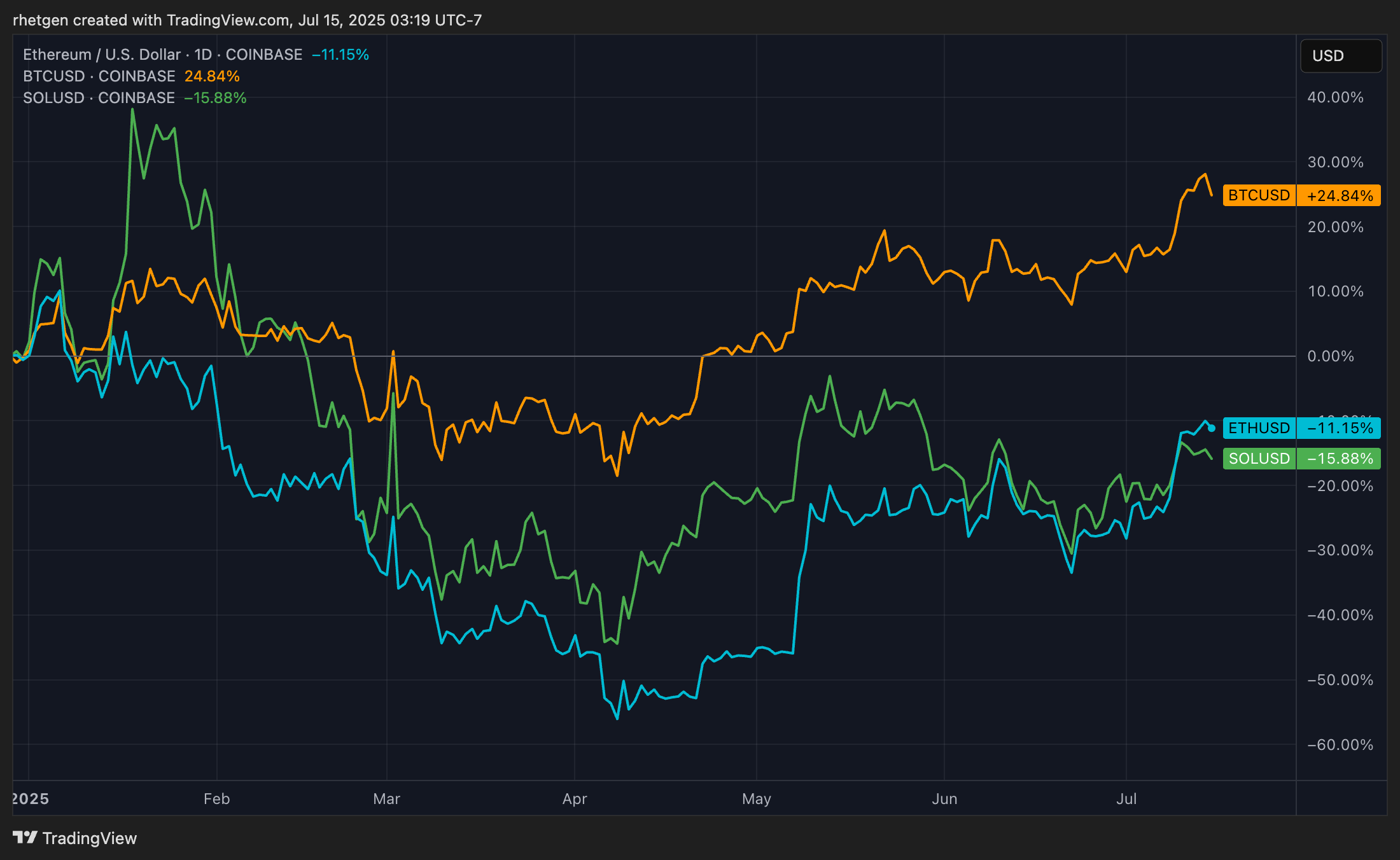The Ethereum Paradox: Why the 'Digital Oil' of Crypto is Losing Its Shine

Bitcoin hit an all time high of $123,000 USD this week and Ethereum crossed the $3000 mark. Is this finally the start of the ETH rally?
Despite this upward swing, Ethereum (ETH) finds itself in an uncomfortable and increasingly overlooked position, like the middle child of the crypto family. ETH has been struggling to capture investor enthusiasm lately. This is curious considering it is the backbone of the decentralized finance movement and the foundation upon which much of the crypto ecosystem is built. Its older sibling Bitcoin reached new all time price highs this year while its younger sibling Solana continues to attract waves of developer activity and new users.
The middle child, Ethereum, appears stuck in a narrative rut that has left many questioning whether the world's second-largest blockchain can reclaim its momentum. When comparing ETH price yearly price movements from 2021-today, it is underperforming all years except for 2022. That year was the “crypto winter” when the market tumbled after a bull 2021 year.

Ethereum, the venerable smart contract platform, remains a titan in the blockchain space. Yet, its journey is increasingly defined by a compelling duality: its foundational role as the "digital oil" powering the decentralized world, juxtaposed with growing market skepticism fuelled by perceived shortcomings and the rising prominence of competitors.
Cryptocurrency is significantly undervalued and poised for substantial growth. It positions ETH as "digital oil," essential for powering the burgeoning digital economy, in contrast to Bitcoin's "digital gold" narrative. Ethereum gained more than BTC and SOL in the month of June. However, it is still underperforming compared to the last bull run in 2021, suggesting that while institutional memory of Ethereum's importance remains, retail enthusiasm has shifted elsewhere.

The Cooling Sentiment
Market sentiment toward ETH dropped to year-low levels as the altcoin underperformed in comparison to other leading crypto assets throughout much of 2024. This skepticism has persisted into 2025.
While Ethereum's monumental shift to Proof-of-Stake (PoS) was a significant engineering feat, it hasn't entirely quelled user frustration. Many express disappointment with Ethereum's ongoing challenges, particularly high transaction fees and scalability constraints on its base layer. Even after upgrades, users frequently face prohibitive "gas fees" during peak network congestion, making micro-transactions or frequent dApp interactions economically unfeasible for many. This pain point has directly contributed to the popularity of alternative Layer 1 blockchains, most notably Solana.
The Solana Challenge
Perhaps nowhere is Ethereum's narrative struggle more apparent than in its competition with Solana. Solana was the biggest draw for new developers, bringing in over 7,000 new developers in 2024, surpassing Ethereum. This developer migration represents more than just numbers—it signals a shifting perception about where innovation happens fastest.

Solana has aggressively carved out its niche by offering significantly lower transaction costs and faster speeds, attracting a substantial user base for specific applications like NFTs and high-frequency trading. Solana dominates memecoin launches and trading while a number of the highest-grossing decentralized applications belong to Solana. This indicates a clear competitive pressure, as users gravitate towards more efficient chains for certain activities. The centralized nature of some staking entities on Ethereum post-Merge also remains a point of critique among decentralization advocates.
The stablecoin market, once Ethereum's domain, tells a similar story. While Ethereum still leads in stablecoins, Solana is rising, with a 67.48% gain in its stablecoin market cap, sitting at $9.8 billion. This growth represents real economic activity migrating to alternative platforms.
Ethereum's Enduring Strengths
Despite these challenges, Ethereum's core value proposition remains robust, firmly rooted in its role as the "digital oil" of the blockchain ecosystem. It continues to play a critical part of the blockchain ecosystem and the foundation of decentralized finance. With over $50 billion in total value locked across its DeFi protocols, Ethereum hosts the most mature and battle-tested financial infrastructure in crypto.
The "digital oil" metaphor remains apt for Ethereum's ecosystem. Just as oil powers traditional industry, ETH serves as the gas that powers smart contract execution on the Ethereum network. Within Ethereum's ecosystem—every DeFi trade, every NFT mint, every dApp interaction requires ETH, creating constant demand pressure. While competitors like Solana have their own native tokens serving similar functions, Ethereum's massive existing ecosystem generates significantly more gas fee demand.
Ethereum's security model also sets it apart. Competitors like Solana, Cardano, and Polkadot offer faster speeds and lower fees, but Ethereum's decentralization and user base keep it ahead of the pack. This decentralization represents more than philosophical purity—it provides the security assurances that major institutions require when deploying capital.
The network's upcoming Pectra upgrade promises to address many technical limitations, potentially revitalizing developer interest. Layer-2 solutions like Arbitrum and Optimism are already demonstrating how Ethereum can scale while maintaining its security guarantees. These networks process transactions at a fraction of Ethereum mainnet costs—often under $0.50 compared to $5-20 on mainnet during peak usage—while inheriting Ethereum's security through cryptographic proofs. Major DeFi protocols like Uniswap and Aave have successfully deployed on these L2s, proving that Ethereum's scaling roadmap can deliver both speed and security.
The Narrative Battle
Ethereum's struggle isn't purely technical—it's narrative. While Solana markets itself as the "iPhone of crypto" with sleek user experiences, and Bitcoin maintains its "digital gold" status, Ethereum's positioning as infrastructure feels less exciting to retail investors seeking quick gains.
The memecoin phenomenon has particularly highlighted this narrative gap. Solana has become the go-to chain for memecoin launches, with tokens like BONK and countless others generating massive trading volumes and retail attention. The combination of low fees and fast transactions makes Solana ideal for the high-frequency, speculative trading that drives memecoin culture. Even newer chains like Base (Coinbase's Layer-2) have captured memecoin mindshare with viral tokens, while Ethereum's higher gas fees often price out the small-dollar traders who fuel these markets. This shift matters because memecoins, despite their speculative nature, drive genuine network usage and attract new users to crypto—users who increasingly bypass Ethereum entirely.
Looking Forward
The future of cryptocurrency may be multi-chain, with networks like Ethereum and Solana coexisting and specializing in different niches.
Some analysts argue this underperformance has created a potential value opportunity, with ETH trading at levels that don't reflect its dominance in DeFi, NFTs, and institutional adoption. The disconnect between Ethereum's fundamental utility—processing over $1 trillion in annual transaction volume—and its market performance suggests the asset may be undervalued relative to its actual economic impact. The approval and launch of Ethereum ETFs in the US represents a significant step forward for institutional adoption, providing traditional investors with regulated exposure to ETH and potentially opening new capital flows that could support long-term price appreciation.
The network is further bolstered by the largest and most active developer community in the blockchain space. This vibrant ecosystem continually builds new dApps, improves core protocols, and ensures Ethereum's adaptability, cementing its long-term relevance.
The key question isn't whether Ethereum will survive—its role as the foundation of DeFi and smart contracts appears secure. Rather, it's whether Ethereum can evolve its narrative to capture the imagination of a new generation of crypto users while maintaining the security and decentralization that made it valuable in the first place.
